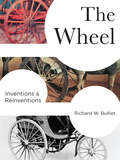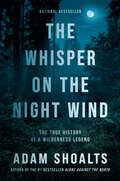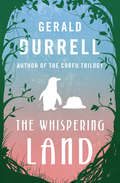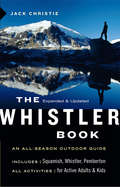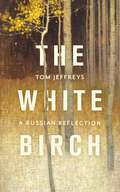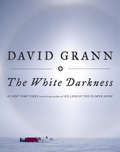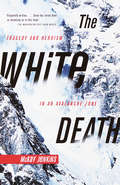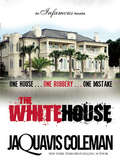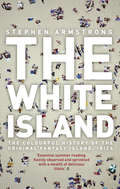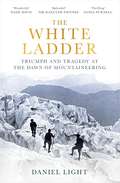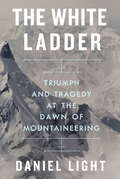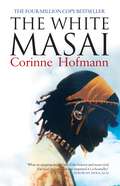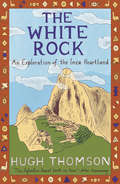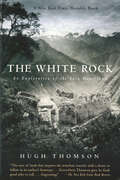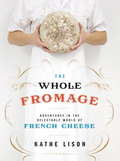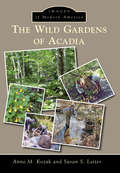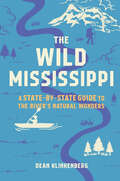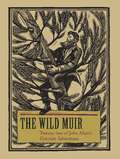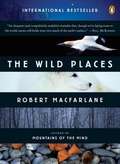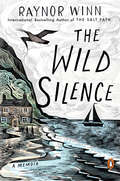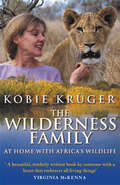- Table View
- List View
The Whaddayah Mean Leave Home and Travel for the Rest of My Life Book
by Gene Townsend Deanne Townsend"Gene and Deanne Townsend are full-time RV'ers who, at ages (Ahem!) "too young to retire" were advised by other full-timers: "If you're gonna' do it, go for it while you're young! Thus, they "sold it all" and hit the road, knowing that it would mean having to work for at least 20 more years. But loving the concept of making the entire United States their home so much, they accepted the challenge wholeheartedly! Now, years later, they are eager to share with you the pros and cons of this lifestyle of freedom!"-About the Authors
The Wheel
by Richard W. BullietIn this book, Richard W. Bulliet focuses on three major phases in the evolution of the wheel and their relationship to the needs and ambitions of human society. He begins in 4000 B.C.E. with the first wheels affixed to axles. He then follows with the innovation of wheels turning independently on their axles and concludes five thousand years later with the caster, a single rotating and pivoting wheel. Bulliet's most interesting finding is that a simple desire to move things from place to place did not drive the wheel's development. If that were the case, the wheel could have been invented at any time almost anywhere in the world. By dividing the history of this technology into three conceptual phases and focusing on the specific men, women, and societies that brought it about, Bulliet expands the social, economic, and political significance of a tool we only partially understand. He underscores the role of gender, combat, and competition in the design and manufacture of wheels, adding vivid imagery to illustrate each stage of their development.
The Wheel: Inventions and Reinventions (Columbia Studies in International and Global History)
by Richard BullietIn this book, Richard W. Bulliet focuses on three major phases in the evolution of the wheel and their relationship to the needs and ambitions of human society. He begins in 4000 B.C.E. with the first wheels affixed to axles. He then follows with the innovation of wheels turning independently on their axles and concludes five thousand years later with the caster, a single rotating and pivoting wheel.Bulliet's most interesting finding is that a simple desire to move things from place to place did not drive the wheel's development. If that were the case, the wheel could have been invented at any time almost anywhere in the world. By dividing the history of this technology into three conceptual phases and focusing on the specific men, women, and societies that brought it about, Bulliet expands the social, economic, and political significance of a tool we only partially understand. He underscores the role of gender, combat, and competition in the design and manufacture of wheels, adding vivid imagery to illustrate each stage of their development.
The Whisper on the Night Wind: The True History of a Wilderness Legend
by Adam ShoaltsSpellbinding adventure from Canada's most beloved modern-day explorer.Traverspine is not a place you will find on most maps. A century ago, it stood near the foothills of the remote Mealy Mountains in central Labrador. Today it is an abandoned ghost town, almost all trace of it swallowed up by dark spruce woods that cloak millions of acres.In the early 1900s, this isolated little settlement was the scene of an extraordinary haunting by large creatures none could identify. Strange tracks were found in the woods. Unearthly cries were heard in the night. Sled dogs went missing. Children reported being stalked by a terrifying grinning animal. Families slept with cabin doors barred and axes and guns at their bedsides.Tales of things that "go bump in the night" are part of the folklore of the wilderness, told and retold around countless campfires down through the ages. Most are easily dismissed by skeptics. But what happened at Traverspine a hundred years ago was different. The eye-witness accounts were detailed, and those who reported them included no less than three medical doctors and a wildlife biologist.Something really did emerge from the wilderness to haunt the little settlement of Traverspine. Adam Shoalts, decorated modern-day explorer and an expert on wilderness folklore, picks up the trail from a century ago and sets off into the Labrador wild to investigate the tale. It is a spine-tingling adventure, straight from a land steeped in legends and lore, where Vikings wandered a thousand years ago and wolves and bears still roam free.In delving into the dark corners of Canada's wild, The Whisper on the Night Wind combines folklore, history, and adventure into a fascinating saga of exploration.
The Whispering Land: A Zoo In My Luggage, The Whispering Land, And Menagerie Manor (The Zoo Memoirs #2)
by Gerald DurrellNaturalist Gerald Durrell recalls his expedition to South America to find exotic animals in this follow-up to A Zoo in My Luggage. After bringing multiple species of African animals back to the Channel Island of Jersey to populate their new zoo, British naturalist Gerald Durrell and his wife followed their passion for wildlife preservation on a journey to South America. With a team of helpers, they spent eight months on safari searching for exotic specimens. Through windswept Patagonian shores and tropical forests in the Argentine, from ocelots to penguins, fur seals to parrots to pumas, the author who inspired the public television drama The Durrells in Corfu captures the landscape and its inhabitants with his signature charm and humor. Filled with adventure, exploration, and the spirit of conservation, The Whispering Land is a memoir that animal lovers of all ages will enjoy. This ebook features an illustrated biography of Gerald Durrell including rare photos from the author&’s estate.
The Whistler Book
by Jack ChristieThis concise, thorough, and easy-to-use guide gives readers all the information they need to enjoy the Whistler area's incredible range of year-round recreational opportunities. It features detailed descriptions of camping, hiking, paddling, and other summer activities, along with winter sports such as skiing, snowboarding, and snowshoeing. Detailed trail maps are provided for each location. Destination highlights, informative sidebars, and author Jack Christie's insider tips on his favorite spots are provided throughout.
The White Birch: A Russian Reflection
by Tom Jeffreys'It has been hand-planted by Tsarinas and felled by foresters. It has been celebrated by peasants, worshipped by pagans and painted by artists. It has self-seeded across mountains and rivers and train tracks and steppe and right through the ruined modernity of a nuclear fall-out site. And like all symbols, the story of the birch has its share of horrors (white, straight, native, pure: how could it not?). But, maybe in the end, what I'm really in search of is a birch that means nothing: stripped of symbolism, bereft of use-value . . . A birch that is simply a tree in a land that couldn't give a shit.'The birch, genus Betula, is one of the northern hemisphere's most widespread and easily recognisable trees. A pioneer species, the birch is also Russia's unofficial national emblem, and in The White Birch art critic Tom Jeffreys sets out to grapple with the riddle of Russianness through numerous journeys, encounters, histories and artworks that all share one thing in common: the humble birch tree.We visit Catherine the Great's garden follies and Tolstoy's favourite chair; walk through the Chernobyl exclusion zone and among overgrown concrete bunkers in Vladivostok; explore the world of online Russian brides and spend a drunken night in Moscow with art-activists Pussy Riot, all the time questioning the role played by Russia's vastly diverse landscapes in forming and imposing national identity. And vice-versa: how has Russia's dramatically shifting self-image informed the way its people think about nature, land and belonging?Curious, resonant and idiosyncratic, The White Birch is a unique collection of journeys into Russia and among Russian people.
The White Darkness
by David GrannBy the #1 New York Times bestselling author of Killers of the Flower Moon, a powerful true story of adventure and obsession in the Antarctic, lavishly illustrated with color photographsHenry Worsley was a devoted husband and father and a decorated British special forces officer who believed in honor and sacrifice. He was also a man obsessed. He spent his life idolizing Ernest Shackleton, the nineteenth-century polar explorer, who tried to become the first person to reach the South Pole, and later sought to cross Antarctica on foot. Shackleton never completed his journeys, but he repeatedly rescued his men from certain death, and emerged as one of the greatest leaders in history.Worsley felt an overpowering connection to those expeditions. He was related to one of Shackleton's men, Frank Worsley, and spent a fortune collecting artifacts from their epic treks across the continent. He modeled his military command on Shackleton's legendary skills and was determined to measure his own powers of endurance against them. He would succeed where Shackleton had failed, in the most brutal landscape in the world. In 2008, Worsley set out across Antarctica with two other descendants of Shackleton's crew, battling the freezing, desolate landscape, life-threatening physical exhaustion, and hidden crevasses. Yet when he returned home he felt compelled to go back. On November 13, 2015, at age 55, Worsley bid farewell to his family and embarked on his most perilous quest: to walk across Antarctica alone.David Grann tells Worsley's remarkable story with the intensity and power that have led him to be called "simply the best narrative nonfiction writer working today." Illustrated with more than fifty stunning photographs from Worsley's and Shackleton's journeys, The White Darkness is both a gorgeous keepsake volume and a spellbinding story of courage, love, and a man pushing himself to the extremes of human capacity.
The White Death: Tragedy and Heroism in an Avalanche Zone
by Mckay JenkinsIn 1969, five young men from Montana set out to accomplish what no one had before: to scale the sheer north face of Mt. Cleveland, Glacier National Park's tallest mountain, in winter. Two days later tragedy struck: they were buried in an avalanche so deep that their bodies would not be discovered until the following June. The White Death is the riveting account of that fated climb and of the breathtakingly heroic rescue attempt that ensued. In the spirit of Peter Matthiessen and John McPhee, McKay Jenkins interweaves a harrowing narrative with an astonishing expanse of relevant knowledge ranging from the history of mountain climbing to the science of snow. Evocative and moving, this fascinating book is a humbling account of man at his most intrepid and nature at its most indomitable.
The White House
by JaQuavis Coleman"The White House is a fast-paced thriller that doesn't disappoint."--Urban Reviews"White House by JaQuavis Coleman starts with a bang and will leave you wanting more."--Book Referees"Kidnapping, murder, and mayhem lead [Draya]--and the reader--through a harrowing and twisting plot to an explosive ending that no one sees coming."--Reading in Black & White"The White House is one of my most personal books ever. I took from a real-life situation and told a story that has been Detroit's secret for years. I'm bringing that to the forefront with my own twist. This venture with Infamous and Akashic feels right...It feels good. They are very in tune with my culture and style of writing which makes this a perfect situation for me."--JaQuavis Coleman on The White HouseThe White House is based on true events, reimagining the dark chronicles of a notorious drug kingpin's death, and the unfortunate events that followed.The young heroine Draya lives paycheck to paycheck, laboring as a maid in a luxurious white house. One day, in the course of performing her duties, she is presented with an irresistible opportunity for a quick--and risky--payday. What unfolds in the white house changes the course of her life. Kidnapping, murder, and mayhem lead her--and the reader--through a harrowing and twisting plot to an explosive ending that no one sees coming. Look through the eyes of this young woman and glimpse how a life can forever be altered due to an unfortunate series of events--all touched off in a legendary white house.Infamous Books, curated by Albert "Prodigy" Johnson of the legendary hip-hop group Mobb Deep, is a revolutionary partnership that pairs the Infamous Records brand with Brooklyn-based independent publisher Akashic Books. Infamous Books' mission is to connect readers worldwide to crime fiction and street lit authors both familiar and new.
The White Island
by Stephen ArmstrongThe White Island is, and always has been, a magnet for hedonists. Its history reads like a history of pleasure itself. It is also a story of invasions and migrations, of artists and conmen, of drop-outs and love-ins. The Carthaginians established a cult to their goddess of sex there, and named the island after Bez, their god of dance. Roman centurions in need of a bit of down time between campaigns would go to Ibiza to get their kicks. And over the centuries, cultures around the Med have used the island either as a playground or a dump for the kind of people who didn't quite fit in back home, but who you'd probably quite like to meet at a party...This is the history of Ibiza, the fantasy island, framed by one long, golden summer where anything can happen - and it usually does.
The White Ladder: Triumph and Tragedy at the Dawn of Mountaineering
by Daniel LightThe true story of the thrill-seekers, map-makers, soldiers, occultists, artists and porters who paved the way for modern mountaineering. &‘A beautifully written and sure-footed history of mountaineering &“before Everest&”, full of wonderful stories and spanning continents and centuries. A splendid debut.&’ Sir Ranulph Fiennes, author of Shackleton Beautiful, remote and dangerous – for generations we have looked to the mountains in awe. Yet, for most, that is where the fascination ends. For a rare few, however, the allure of the peaks proved irresistible. There are the devout Incan priests who, scaling the Andes&’ icy slopes to pay tribute to each mountain&’s &‘Great Lord&’, travelled higher than any European would for centuries. The Gurkha riflemen who joined their commanders in canvassing the Karakoram, admiring the distant summits of Broad Peak and K2 with gleeful anticipation. The tweed-clad mountaineers who made the first serious assaults on Everest, hauling yards upon yards of battered rope through the cold. Tracing the world altitude record from the ashy slopes of the sacred volcano Llullaillaco to the icy crags and crevasses of the Karakoram, Daniel Light takes a panoramic journey through the storied history of mountaineering before Everest. Joining a cast of colourful characters, The White Ladder offers an ode to mountains&’ capacity to enthral, and the fundamental human drive to climb higher and higher. *** 'Thrilling... Daniel Light delivers stories that are poetic, spiritual and astonishing in their courage and drive.' Sonia Purnell, author of A Woman of No Importance &‘Daniel Light guides the reader through a mountain-scape that stretches from the Alps to the Himalaya... with the sure footing of a serious student of climbing history, and the élan of a skilled storyteller. This is a book to curl up with on a cold dark night in a comfortable armchair before a bright fire.&’ Maurice Isserman, co-author of Fallen Giants &‘Wonderful… a massive story with an enormous cast of characters, among them some of the most compelling figures of mountaineering history.&’ Wade Davis, author of Into the Silence
The White Ladder: Triumph and Tragedy at the Dawn of Mountaineering
by Daniel LightA sweeping history of mountaineering before Everest, and the epic human quest to reach the highest places on Earth. Whether in the name of conquest, science, or the divine, humans across the centuries have had myriad reasons to climb mountains. From the smoking volcanoes of South America to the great snowy ranges of the Himalaya, The White Ladder follows a cast of extraordinary characters—conquistadors and captains, scientists and surveyors, alpinists and adventurers—up the slopes of the world’s highest peaks. A masterpiece of edge-of-your-seat narrative history, The White Ladder describes the epic rise of mountaineering’s world altitude record, a story of ever higher climbs by figures great and small of mountaineering during the nineteenth and early twentieth centuries. Daniel Light describes how climbers used revolutionary techniques to launch themselves into the most forbidding conditions. The expeditions illustrate evolutionary changes in climbing style, the advancement of high-altitude science, and the development of mountain climbing as an industry. Throughout, Light pays special attention to Incan climbers, Gurkha guides, Sherpa mountaineers, and many others who are often overlooked. He offers nuanced new perspectives on familiar characters, for example, calling out the famed female pioneer Fanny Bullock Workman for racism and for abusing her porters. He presents a complex new portrait of notorious occultist Aleister Crowley, who was at once a ruthless expedition leader, but also an innovative strategist who could read mountains and would risk everything trying to climb them. Light also makes bold new arguments about classic debates, for example, arguing that the much-maligned Jewish climber Oscar Eckenstein shaped mountaineering as we know it today. A story of innovation, invention, and determination, The White Ladder immerses readers in a fascinating historical period. With their breathtaking exploits, these climbers laid the groundwork for the historic ascents of K2 and Everest that came after—and heightened the spectacle of their dangerous sport.
The White Masai
by Corinne HofmannCorinne Hofmann falls in love with a Masai warrior while on holiday with her boyfriend in Kenya. After overcoming all sorts of obstacles, she moves into a tiny shack with him and his mother in his village, and spends four years in Kenya. Slowly but surely the dream starts to crumble until she flees back home with her baby daughter born out of the seemingly indestructible love between a white European woman and a Masai. This is a major feature film to be released in the UK 2006.
The White Rock: An Exploration of the Inca Heartland
by Hugh ThomsonOne man goes in search of the lost cities of the Amazon in the Inca heartland.The lost cities of South America have always exercised a powerful hold on the popular imagination. The ruins of the Incas and other pre-Colombian civilisations are scattered over thousands of miles of still largely uncharted territory, particularly in the Eastern Andes, where the mountains fall away towards the Amazon. Twenty-five years ago, Hugh Thomson set off into the cloud-forest on foot to find a ruin that had been carelessly lost again after its initial discovery. Into his history of the Inca Empire he weaves the story of his adventures as he travelled to the most remote Inca cities. It is also the story of the great explorers in whose footsteps he followed, such as Hiram Bingham and Gene Savoy.
The White Rock: An Exploration of the Inca Heartland
by Hugh ThomsonOne man goes in search of the lost cities of the Amazon in the Inca heartland.The lost cities of South America have always exercised a powerful hold on the popular imagination. The ruins of the Incas and other pre-Colombian civilisations are scattered over thousands of miles of still largely uncharted territory, particularly in the Eastern Andes, where the mountains fall away towards the Amazon. Twenty-five years ago, Hugh Thomson set off into the cloud-forest on foot to find a ruin that had been carelessly lost again after its initial discovery. Into his history of the Inca Empire he weaves the story of his adventures as he travelled to the most remote Inca cities. It is also the story of the great explorers in whose footsteps he followed, such as Hiram Bingham and Gene Savoy.
The White Rock: An Exploration of the Inca Heartland
by Hugh ThomsonAn explorer searches the Peruvian Andes for a lost ruin in “a gem of a book [that] transcends the travel writing genre” with fascinating Inca history (Los Angeles Times).A New York Times Notable BookWith the backdrop of the ever-intriguing Andes mountains, Hugh Thomson explores the intoxicating history of the Inca people and their heartland. The author, an acclaimed documentary filmmaker and explorer, expertly weaves accounts of his own discoveries and brushes with danger with the history of those who preceded him—including the explorer Hiram Bingham, who discovered Machu Picchu; the twentieth century South American photographer, Martín Chambi; the poet Pablo Neruda; and the Spanish conquistadores who destroyed the Inca civilization—and the eccentric characters he meets on his travels.Following in the footsteps of the explorers Gene Savoy and Hiram Bingham, Thomson set off into the jungle to find the lost city of Llactapat. This is the story of his journey to discover it via the interconnecting paths the Incas laid across the Andes.
The Whole Fromage: Adventures in the Delectable World of French Cheese
by Kathe LisonThe French, sans doute, love their fromages. And there's much to love: hundreds of gloriously pungent varieties--crumbly, creamy, buttery, even shot through with bottle-green mold. So many varieties, in fact, that the aspiring gourmand may wonder: How does one make sense of it all? In The Whole Fromage, Kathe Lison sets out to learn what makes French cheese so remarkable--why France is the "Cheese Mother Ship," in the words of one American expert. Her journey takes her to cheese caves tucked within the craggy volcanic rock of Auvergne, to a centuries-old monastery in the French Alps, and to the farmlands that keep cheesemaking traditions alive. She meets the dairy scientists, shepherds, and affineurs who make up the world of modern French cheese, and whose lifestyles and philosophies are as varied and flavorful as the delicacies they produce. Most delicious of all, she meets the cheeses themselves--from spruce-wrapped Mont d'Or, so gooey it's best eaten with a spoon; to luminous Beaufort, redolent of Alpine grasses and wildflowers, a single round of which can weigh as much as a Saint Bernard; to Camembert, invented in Normandy but beloved and imitated across the world. With writing as piquant and rich as a well-aged Roquefort, as charming as a tender springtime chèvre, and yet as unsentimental as a stinky Maroilles, The Whole Fromage is a tasty exploration of one of the great culinary treasures of France.From the Trade Paperback edition.
The Wild Gardens of Acadia (Images of Modern America)
by Anne M. Kozak Susan S. LeiterFounded in 1961 at Sieur de Monts Spring in Maine's Acadia National Park, the Wild Gardens of Acadia display, preserve, propagate, and label native plants in areas simulating natural plant communities. The gardens, which originated from a competition in growing native plants sponsored by the Bar Harbor Garden Club, continue to be developed and maintained by volunteers in partnership with Friends of Acadia and Acadia National Park. Each of the gardens' 13 habitats, ranging from mountain to beach to bog to deciduous and coniferous woods, displays plants native to the park. Since the founding, countless park visitors have come to the gardens to identify plants they have seen on walks or hikes or to learn more about cultivating native plants. Many of the images in this book are drawn from the extensive photograph collection of the Wild Gardens of Acadia.
The Wild Mississippi: A State-by-State Guide to the River's Natural Wonders
by Dean KlinkenbergDiscover the amazing flora and fauna of the Mississippi River—and the best ways to explore it, state by state! Did you know that one-quarter of all North American fish species are native to the Mississippi? Or that it shelters 300 species of birds during seasonal migrations? The Mississippi River runs through the heart of the nation, shaping its history and identity. But few of us understand its essences. It&’s a life-giving force that sustains thriving ecosystems across wetlands, prairies, and bluffs. In The Wild Mississippi, Dean Klinkenberg not only shares the wonders of the river, but he also shows you where to experience them firsthand. Pick up this must-read guide and get ready to experience the river wild! You&’ll discover: Hiking, biking, and paddling spots More than 160 parks, forests, and wildlife refuges Natural history museums and aquariums Excursions from Minneapolis, St. Louis, Memphis, New Orleans, and more
The Wild Muir
by Lee StetsonHere is an entertaining collection of John Muir's most exciting adventures, representing some of his finest writing. From the famous avalanche ride off the rim of Yosemite Valley to his night spent weathering a windstorm at the top of a tree to death-defying falls on Alaskan glaciers, the renowned outdoorsman's exploits are related in passages that are by turns exhilarating, unnerving, dizzying, and outrageous.
The Wild Places
by Robert MacfarlaneAre there any genuinely wild places left in Britain and Ireland? Or have we tarmacked, farmed and built ourselves out of wildness? In The Wild Places, Macfarlane embarks on a series of journeys in search of the wildness that remains in these islands. His journeys take him through some of the most remarkable landscapes of our archipelago. He climbs, walks and swims through these places in rainstorm, sunlight and blizzard, by darkness and by day, and in all seasons. He spends nights sleeping out on cliff-tops and remote beaches, deep in snowy woods, on pilgrim islands, mountain summits, and ancient meadows. He bathes in phosphorescent seas, walks frozen rivers at night, and watches a red sun rise over an Arctic England. In the course of his journeys, Macfarlane's own understanding of wildness undergoes a transformation.
The Wild Places
by Robert Macfarlane?An eloquent (and compulsively readable) reminder that, though we?re laying waste the world, nature still holds sway over much of the earth?s surface.? ?Bill McKibben Are there any genuinely wild places left in Britain and Ireland? That is the question that Robert Macfarlane poses to himself as he embarks on a series of breathtaking journeys through some of the archipelago?s most remarkable landscapes. He climbs, walks, and swims by day and spends his nights sleeping on cliff-tops and in ancient meadows and wildwoods. With elegance and passion he entwines history, memory, and landscape in a bewitching evocation of wildness and its vital importance. A unique travelogue that will intrigue readers of natural history and adventure, The Wild Places solidifies Macfarlane?s reputation as a young writer to watch.
The Wild Silence: A Memoir
by Raynor WinnAN INTERNATIONAL BESTSELLERThe incredible follow-up to the international bestseller The Salt Path, a story of finding your way back home.Nature holds the answers for Raynor and her husband Moth. After walking 630 homeless miles along The Salt Path, living on the windswept and wild English coastline; the cliffs, the sky and the chalky earth now feel like their home. Moth has a terminal diagnosis, but together on the wild coastal path, with their feet firmly rooted outdoors, they discover that anything is possible.Now, life beyond The Salt Path awaits and they come back to four walls, but the sense of home is illusive and returning to normality is proving difficult - until an incredible gesture by someone who reads their story changes everything. A chance to breathe life back into a beautiful farmhouse nestled deep in the Cornish hills; rewilding the land and returning nature to its hedgerows becomes their saving grace and their new path to follow. The Wild Silence is a story of hope triumphing over despair, of lifelong love prevailing over everything. It is a luminous account of the human spirit's connection to nature, and how vital it is for us all.
The Wilderness Family
by Kobie KrugerWhen Kobie Krüger, her game-ranger husband and their three young daughters moved to one of the most isolated corners of the world - a remote ranger station in the Mahlangeni region of South Africa's vast Kruger National Park - she might have worried that she would become engulfed with loneliness and boredom. Yet, for Kobie and her family, the seventeen years spent in this spectacularly beautiful park proved to be the most magical - and occasionally the most hair-raising - of their lives.Kobie recounts their enchanting adventures and extraordinary experiences in this vast reserve - a place where, bathed in golden sunlight, hippos basked in the glittering waters of the Letaba River, storks and herons perched along the shoreline, and fruit bats hung in the sausage trees.But as the Krugers settled in, they discovered that not all was peace and harmony. They soon became accustomed to living with the unexpected: the sneaky hyenas who stole blankets and cooking pots, the sinister-looking pythons that slithered into the house, and the usually placid elephants who grew foul-tempered in the violent heat of the summer. And one terrible day, a lion attacked Kobus in the bush and nearly killed him.Yet nothing prepared the Krugers for their greatest adventure of all, the raising of an orphaned prince, a lion cub who, when they found him, was only a few days old and on the verge of death. Reared on a cocktail of love and bottles of fat-enriched milk, Leo soon became an affectionate, rambunctious and adored member of the fmaily. It is the rearing of this young king, and the hilarious endeavours to teach him to become a 'real' lion who could survive with his own kind in the wild, that lie at the heart of this endearing memoir. It is a memoir of a magical place and time that can never be recaptured.

